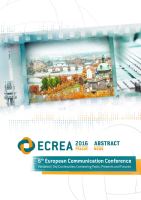

331
Friday, November 11
1 8 : 0 0 – 1 9 : 3 0
ICS05
Ways of Communicating in Professional Relations
PP 490
Communication Styles of Greek Preschool, Primary and Secondary School Teachers Based on Their Personal Perceptions Related to
Nonverbal Immediacy During the Teaching Process
P.J. Stamatis
1
, M.J. Ntavlamanou
2
1
University of the Aegean, Department of Sciences of Preschool Education and Educational Design, Rhodes, Greece
2
Primary Education of Dodecanese, Rhodes, Greece
According to literature review, teaching immediacy consists a key aspect for improving the teaching process and academic achievement of students, be‑
cause it affects in a positive way on interpersonal relationships among teachers and students. Teaching immediacy makes the lesson more interesting and
the instructor looks more motivating and enthusiastic. This view is based on a series of researches that have been implemented over the last three decades
in the USA, in many European and other countries all over the world. Teaching immediacy has been particularly investigated by professors V. P. Richmond,
J. C. McCroskey, & A. D. Johnson (2003). They constructed the Nonverbal Immediacy Scale - Self Report (NIS-S). This scale aims in reporting of personal
opinions' of teachers regarding to the contribution of nonverbal behavior in creating immediacy during teaching. Within the above-mentioned theoretical
framework, this study examines the teaching style of the Greek teachers who teach in public kindergarten, primary and secondary education schools, as
it is estimated by the analysis of their own perceptions regarding to the issue. For the reporting of teachers’ perceptions the standardized scale Nonverbal
Immediacy Scale - Self Report (NIS-S) was used after its translation into Greek and pilot test implemented by the researchers of this study. In this study
nine hundred and thirty five teachers of preschool, primary and secondary education were participated in total. Actually, those teachers were constituted
the final sample of the research.The provided answers were statistically processed with SPSS 20.0. After extracting the individual score of each participating
teacher the hermeneutic method was used for analyzing the overall results and conclusions per level of education (preschool, primary, secondary), which
were based on quantitative data obtained by the descriptive analysis of provided answers.The study concludes that the teaching immediacy of Greek teach‑
ers appears inversely proportional to the class they teach. Teachers who teach in kindergartens and nursery schools appear the highest teaching immediacy
than all participants. Teachers who teach in primary schools seem having less teaching immediacy in comparison with previously mentioned teachers even
though they hold a very satisfactory level indeed. Teachers who teach in secondary schools stated significantly less teaching immediacy than all previous
mentioned teachers naming various reasons. The findings indicates that in spite Greek teachers have already acquired a satisfactory level of teaching im‑
mediacy, there is enough space for the improvement of their nonverbal behavior aspects during teaching process in order to be more able in enhancing this
very aspect and through this their classroom communication style and teaching effectiveness as well.
PP 491
Exploring Difference as a Dynamic of Dialogue: A Study of the Relational Construction of “Person-Centred” Care in an Interdisciplinary
Social and Health Care Team
L. Phillips
1
1
Roskilde University, Communication and Arts, Roskilde, Denmark
In dialogue-based communication, communication is configured as dialogue in which multiple social actors co-produce knowledge collaboratively across
multiple knowledge forms and knowledge interests. According to dialogic ideals, expert knowledge is democratized as multiple ways of knowing are rec‑
ognized as legitimate. Crucially, difference is viewed as the transformative force in the co-construction of knowledge in dialogue. By harnessing difference
as a transformative force, it is claimed, dialogue can generate knowledge across difference, including differences of organizational position and professional
background, theoretical perspective, gender, ethnicity, class and so on. But how exactly is knowledge co-produced in dialogue through the harnessing
of “difference” as a transformative force? And what tensions are in play in dynamics of inclusion and exclusion where some voices, articulating particular
forms of knowledge and subjectivities, dominate and others are marginalised? The paper examines these questions through empirical analysis of the col‑
laborative practices of an interdisciplinary social and health care team in Australia which offers advice to residential care home workers on“person-centred”
care for residents with dementia. The theoretical framework, The Integrated Framework for Analysing Dialogic Knowledge Production and Communication
(IFADIA), is based on a combination of Bakhtinian dialogic communication theory and Foucault’s theorization of discourse and power/knowledge. The the‑
oretical framework is applied in empirical analysis of how knowledge is co-produced collaboratively across difference in social interaction in six team case
meetings. Methods of data production are video and audio recording and participant observation. The focus of the analysis is on the relational construction
of“person-centred care”and the collective identity of the team in opposition to the practices and identities of residential care workers and relatives of resi‑
dents.The analysis shows how knowledge is co-produced within a discourse which constructs a particular understanding of“person-centred care”, particular
social relations within the team and between the team, residential care workers, residents and relatives, and particular identities for team members, care
workers, residents and relatives.Within the discourse,“person-centred care”is ascribed meaning qua its difference from non-person-centred care, and a col‑
lective identity as advisory team is created through the difference from care-workers. A strong team“we” is (re)produced that engages in “person-centred
care” and treats residents in the normatively correct, “person-centred” way in opposition to the residential care personnel-“Other” who treat residents in
the normatively wrong, non-person-centred way. The conclusion explores the implications of the empirical results in relation to dynamics of inclusion and
exclusion at work in the harnessing of“difference” in dialogue. It is concluded that inclusion and exclusion are in play in the relational construction of“per‑
son-centred care”and identities as advisory team and residential care workers. In particular, the construction of residential care workers as the Other who
do not treat residents in the normatively correct way has implications for the knowledge about “person-centred care” that is produced and the relations
that are established and maintained in social interaction between the team and residential care workers. It can be argued that it limits how dialogic and
person-centred that social interaction can be.



















